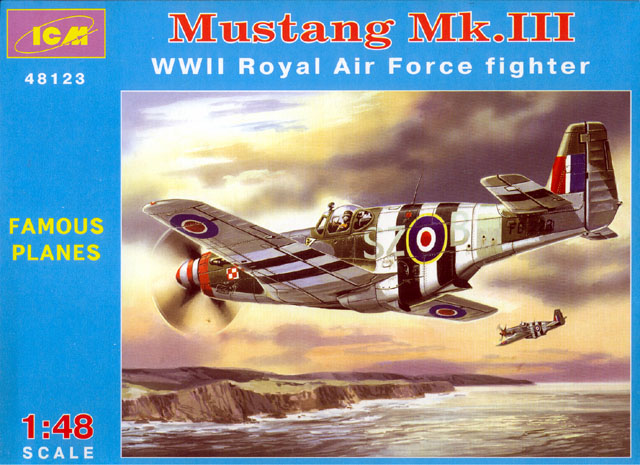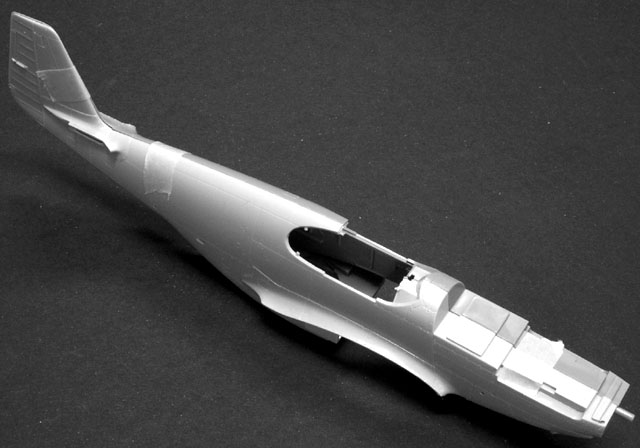|
Mustang Mk.III
ICM


HyperScale is proudly supported by Squadron.com
S
u m m a r y
|
| Catalogue Number: |
48123 |
| Scale: |
1/48 |
| Contents and Media: |
78 parts in pale grey styrene; 11
parts in clear styrene |
| Price: |
|
| Review Type: |
First Look |
| Advantages: |
Tamiya quality surface
features and detail; optional propellers, spinners, seats, wheels, hubs
and ordnance; low price. |
| Disadvantages: |
Majority of
parts are obviously based on Tamiya's 1/48 scale P-51B/C kits; some greasy
mould release agent still on plastic parts; minor flash present; one-piece canopy/windscreen;
incorrect cockpit floor configuration. |
| Recommendation: |
Recommendation withheld |
Reviewed by
Brett Green
Tamiya's 1/48 scale P-51B / Mustang III kits are considered to be a classic
of the 1990s. An accurate outline, beautiful surface features and great detail
straight from the box has endeared this kit to many modellers.
So what is Tamiya's 1/48 scale Mustang doing in an ICM box?
When ICM's Mustang III was delivered to my home early one morning
last week I was excited and amazed. The quality was superb. My first
impression was that this kit represented ICM's finest work. Indeed, it
looked as good as a Tamiya kit.
Later that day I laid out the ICM Mustang III and Tamiya's "RAF
Mustang III" to
compare and contrast the respective kits. I was initially surprised to
see the similarities and, within a few minutes, genuinely shocked to
find that the major parts were interchangeable. I taped the ICM right
fuselage half to the Tamiya left fuselage half - perfect match. The
same can be said for the wings, the tailplanes and most of the remaining
parts.
So, if both these kits are dimensionally accurate, would it not be
reasonable to assume that they would be interchangeable? Perhaps, but
the engineering of the major assemblies is also identical. Tamiya
employed a peculiar method to ensure a stable fit for the top cowl part.
ICM's kit shares this method to the millimetre.
|
 |
|
Snap! Even with
no glue and minimal tape, the ICM right fuselage half fits perfectly
with the left Tamiya fuselage half. Note the intricate engineering
on the top of the forward cowl, also identical on both kits. |
The main errors of the Tamiya kit are also faithfully reproduced. The
curved metal cockpit floor, the broadly splayed cuffs on the propeller
blades and the spacing of the wing machine guns are
the same on both kits.
The only difference I can see on the fuselage exterior is the
addition of two subtle rows of engraved rivets and the removal of the
integrated tail wheel doors. These doors are now supplied as separate
pieces.
Click the thumbnails below
to view larger images:
|
|

|
|
The contours of the lower fuselage also match perfectly
|
|

|
|
The upper ICM wings have been taped to the lower Tamiya wing. Note the excellent join at the wing root.
|
|

|
|
The perfect match between the wheel well structural detail on the ICM upper wing with the Tamiya lower wing is obvious here.
|
|

|
|
No tape, no glue, no modification - the ICM horizontal stabilisor has been cut straight off the sprue and slotted into the Tamiya rear fuselage.
|
|
|
Despite the substantial common parts, ICM has added some non-Tamiya
content. The tail wheel has been improved, and alternate parts are
supplied for bulged main wheels, optional ordnance, seats, propellers
and spinners. A Malcolm Hood is supplied in addition to the standard
framed canopy. The pilot is different too - he looks fairly miserable.
Furthermore, the cockpit is broken down differently to the Tamiya
kit. Sidewall structural details are separate parts, and the instrument
panel is supplied in clear, a la Accurate Miniatures (although
the pattern of the panel is the same as the Tamiya part). Indeed, a
second clear instrument panel is supplied, but as far as I can tell this
seems to be for an Allison Mustang. Curiously, no instrument decal is
supplied to glue to the back of the clear panel, but if you have the
Tamiya kit, the decal instruments supplied with that kit will fit.
Apart from the previously mentioned errors, there are a few more
minor nitpicks specific to the ICM kit. The fuselage and wings feel
slightly greasy. This is probably mould release agent. The kit parts
should be thoroughly cleaned in warm (not hot!) soapy water before
assembly. There is some flash present on the ICM parts, but this should
only take a few minutes to remove. Finally, the framed hood and
windscreen is moulded as one part. It will be quite tricky to separate
the side and the top to display the canopy open. Interestingly, the
Tamiya kit does provide the option of an open hood in their Mustang III.
The source of the ICM Mustang's
main parts could not be more
obvious if they had "Tamiya" stamped in relief on the plastic.
The addition of two lines of rivets, an improved tailwheel, a new pilot,
the rearrangement of cockpit sidewalls and the inclusion of
options for wheels and ordnance does not alter the fact that this kit
remains substantially Tamiya in origin and design.
However, we do live in an age where one
company's kit turns up later in someone else's box. This is often a simple
commercial arrangement between two consenting companies. We have seen
many useful examples of an old mould getting a new lease of life -
Dragon kits in Revell boxes for example. Perhaps ICM
have paid Tamiya for the rights to use the Mustang tooling. I have
requested ICM to advise if this is the situation via emails to their
Head Office and ICM USA, but there has been no reply to date.
On the one hand, ICM have delivered a
kit which, in some respects, is superior to the model on which it was so
clearly based.
On the other hand, I feel that it would
be inappropriate to recommend this kit until the important questions
about the source of the tooling are answered. As soon as I hear from ICM,
I will update this review. In the meantime, I will reserve my judgment
and my recommendation.
Recommendation Withheld
Review and Images Copyright © 2001 by Brett
Green
Page Created 12 December, 2001
Last updated 22 July, 2003
Back to HyperScale Main Page
Back to Reviews Page
|
Home | What's
New | Features
| Gallery |
Reviews | Reference
| Forum
| Search